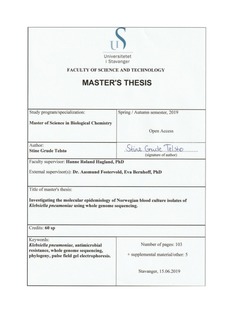| dc.description.abstract | Abstract
Antimicrobial resistance (AMR) is a rapidly increasing threat to public health, and was in 2019 listed as one of top ten global health threats by the World Health Organization (WHO). The gram-negative Enterobacteriaceae Klebsiella pneumoniae (K. pneumoniae) has as a ranking of “Priority 1: Critical” on WHOs list of pathogens, due to its development of multi-drug resistance (MDR) towards last-line antibiotics.
The development of new effective antibiotics, as well as research on this bacteria is much needed to limit and ultimately reduce the spread and evolvement of resistant and highly pathogenic strains. Strengthened prevention and infection control and increased surveillance as well as utilization of the “One Health” approach are all actions to regard for an effective strategy against AMR.
Whole genome sequencing (WGS) can aid in characterization, detection, tracking and surveillance of the evolution and emergence of AMR related strains. WGS enables accurate characterization of transmission and outbreaks by allowing comparison of clinical isolates with an accuracy of a single nucleotide difference. WGS also provides knowledge of the presence resistance- and virulence genes, and the number of SNPs in the whole genome, as well as information on conserved and variable genes in various lineages. Phylogenetic analysis, such as core genome MLST, can uncover specific sequence types (STs) associated with resistance- or virulence genes, and genetic relations between clinical isolates.
PFGE was and still is considered the “gold standard” for bacterial strain typing in many laboratories. This method was therefore compared to a WGS based strain typing method to see if there is correlation or large differences between effectiveness, reliability and resolution in the two methods.
In this thesis, a collection of 722 K. pneumoniae strains provided by the NORKAB study was whole genome sequenced and analyzed to describe the genetic epidemiology between the isolates. Investigations were carried out with the phylogenetic analysis methods; core genome analysis and single nucleotide polymorphism (SNP) analysis. The phylogenetic analysis of the WGS data was compared with phylogenetic analysis of pulse field gel electrophoresis (PFGE) data.
In the investigated K. pneumoniae population, multilocus sequence typing (MLST) analysis revealed a diverse distribution, with a total of 378 different STs, with seven prevalent variants, ST107 (n=67), ST20 (n=23), ST37 (n=20), ST45 (n=18) and ST307, ST25 and ST26 (n=12). Locus variants (LV) we detected in 178 isolates, distributed among 147 different LVs. In addition, three new STs were assigned to three of the isolates from the population.
No significant geographical differences were found in the distribution of STs, except for a few local build-ups of ST10 (8/8) and ST107 (49/67) in both the West and the South regions, and ST220 (5/6) and ST29 (5/8) in the East region, but the Middle region was under-represented with only one participation hospital.
The most prevalent ST, ST107, was investigated through PFGE and core genome SNP analysis. PFGE analysis indicated clonality in 33/37 isolates, based on a one band difference in the DNA fingerprints, and no positional differences. Core genome SNP analysis of the same isolates suggested close relations, based on an average SNP difference of ~15±6. The suggested SNP difference for indication of clonal isolates is ≤10. This showed that core genome SNP analysis has a stronger discriminative power and a higher resolution to differentiate isolates than that of PFGE. The core genome SNP analysis did not suggest clonality in the same number of isolates as the DNA fingerprint analysis did.
A large diversity of sequence types was identified among clinical isolates of K. pneumoniae from five geographical regions of Norway. The most prevalent, ST107, was found in all regions, with higher incidence in the South- and West regions. The majority of isolates were characterized as closely related, and some were characterized as clonal. Comparison of PFGE and core genome SNP analysis of the isolates suggested a higher discriminative power in the latter method. | nb_NO |

